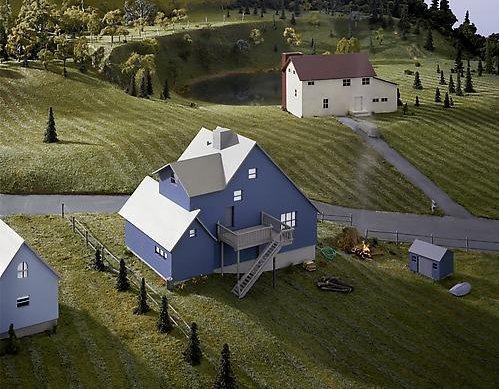James Casebere
dal 27/10/2010 al 3/12/2010
Segnalato da
27/10/2010
James Casebere
Sean Kelly Gallery (old location), New York
House. His new works feature his largest and most ambitious architectural model to date, in which he painstakingly recreated his impressions of an area of Dutchess County that he happened upon by accident during a road trip to upstate New York. Taking two years and innumerable man-hours to build, the model became so large that it eventually commandeered the entire studio. Over the years, sections of the model were destroyed and obsessively rebuilt on numerous occasions to create different labyrinthian vignettes.

For the past three decades, Casebere has constructed architectural models of increasing complexity, photographing them under carefully controlled lighting conditions in his studio. Casebere’s dynamic new works, which will be exhibited in the main gallery, feature his largest and most ambitious architectural model to date, a model in which he painstakingly recreated his impressions of an area of Dutchess County that he happened upon by accident during a road trip to upstate New York. Taking two years and innumerable man-hours to build, the model became so large that it eventually commandeered the entire studio. Over the years, sections of the model were destroyed and obsessively rebuilt on numerous occasions – at times, holes had to be cut to accommodate the camera – to create different labyrinthian vignettes.
The first two photographs in the series were shown in the 2010 Whitney Biennial to great critical acclaim. Connecting the works to the subprime mortgage crisis, critics commonly saw these images as a commentary on the reckless housing market boom, an absurdly unsustainable lifestyle and the loss of the attendant American dream of home ownership and increased generational prosperity. Casebere explains that while he acknowledges the new works’ potential political implications, the imagery is more of a reflection of his personal interest and ultimate fascination with this geographic region as a subject; its ad-hoc architecture became a portrait of the development of a neighborhood and its inhabitants.
Employing verisimilitude as one of his artistic tools, Casebere’s photographs often create a mood of emotional isolation. All of Casebere’s images are conspicuously absent of human form. However, one sees evidence of habitation in subtle ways: lights shining through windows, fires burning and garden hoses on lawns. By removing direct references to the human figure, Casebere creates an abstract narrative, allowing the viewers to place themselves within the image, in a sense completing the work.
A group of important early black and white photographs, to be shown in the two other galleries, give historical context to and chart the trajectory of Casebere’s use of architecture to evoke dream-like memories of places that are familiar, but not specific. As the writer Jennifer Yum has explained, because Casebere’s photographs “are resemblances and approximations and never rote documentations of physical sites, their iconic nature is suggested, as though identification of the space rests in the periphery of the viewer’s recollection.” These pared-down quasi-surreal American landscapes, the subjects of which vary from the desolate Southwest to urban row houses in Baltimore, chronicle places that Casebere encountered during his life that had a lasting aesthetic and emotional impact.
James Casebere is represented in public and private collections worldwide including the Museum of Modern Art, New York; the Solomon R. Guggenheim Museum, New York; the Metropolitan Museum of Art, New York, the Whitney Museum of American Art, New York, the National Gallery of Art, Washington, DC; the National Gallery of Canada, Ottawa; the Goetz Collections, Munich, Germany, the Mukha Museum, Antwerp, Belgium; the Victoria and Albert Museum, London, England; and the Tate Modern, London, England. In addition to his participation in the 2010 Whitney Biennial, Casebere was most recently included in the Pictures Generation exhibition at the Metropolitan Museum of Art in 2009 and Haunted: Contemporary Photography/Video Performance, at the Solomon R. Guggenheim Museum in 2010. Casebere was commissioned by The New York Times to create an image from his new series for the October 17th issue of the paper’s Sunday Magazine.
Please contact Maureen Bray at the gallery (212.239.1181) or maureen@skny.com for more information.
The opening will take place on Thursday, October 28th from 6pm to 8pm. The artist will be present.
Sean Kelly Gallery
528 West 29th Street New York NY 10001
Gallery hours are Tuesday through Friday from 11am until 6pm and Saturday from 10am until 6pm.



